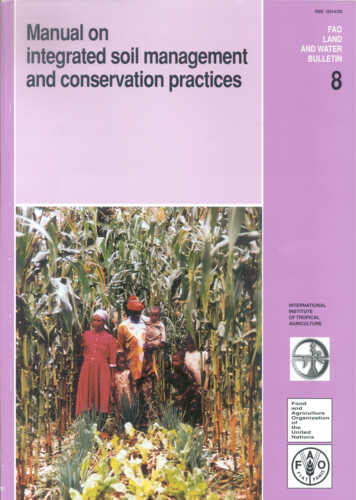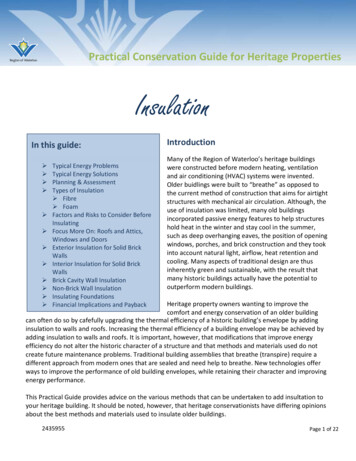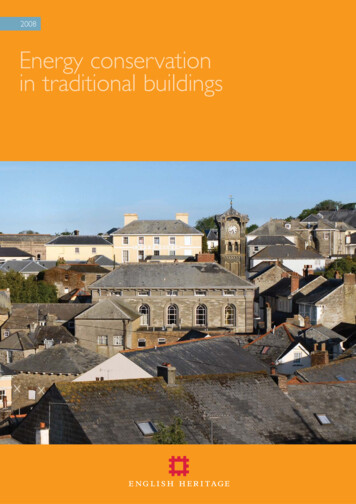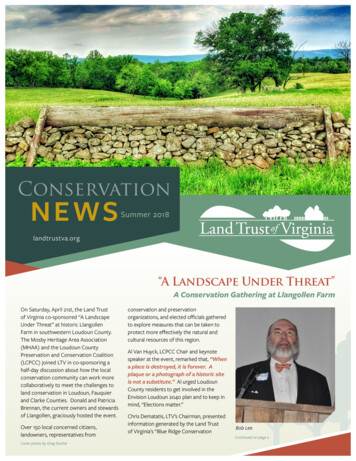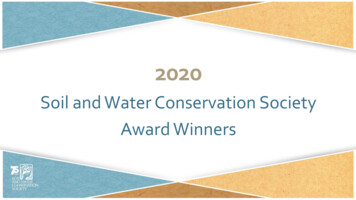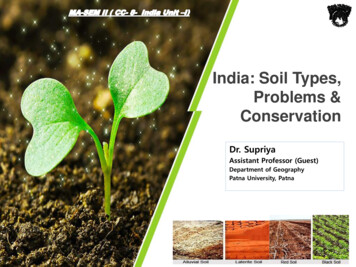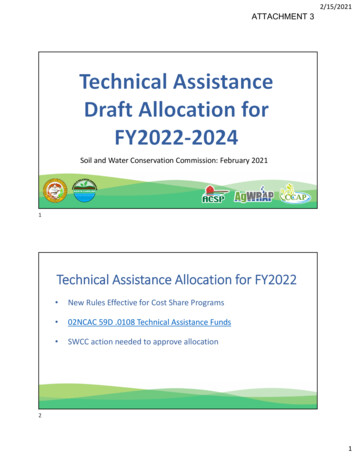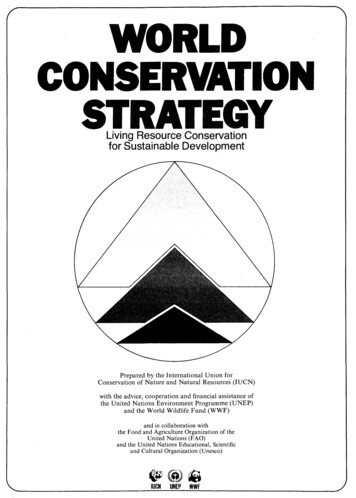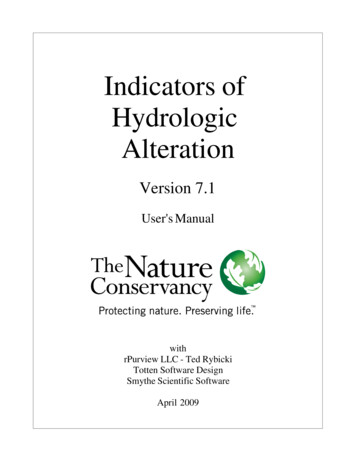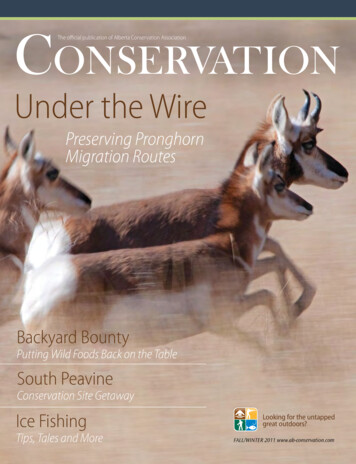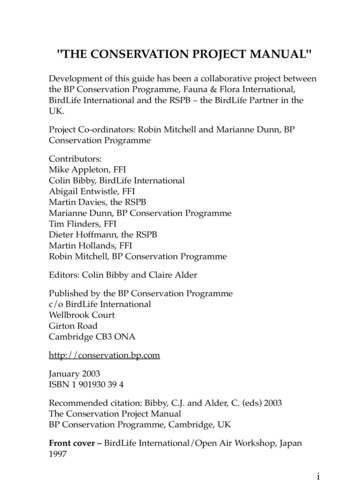
Transcription
"THE CONSERVATION PROJECT MANUAL"Development of this guide has been a collaborative project betweenthe BP Conservation Programme, Fauna & Flora International,BirdLife International and the RSPB – the BirdLife Partner in theUK.Project Co-ordinators: Robin Mitchell and Marianne Dunn, BPConservation ProgrammeContributors:Mike Appleton, FFIColin Bibby, BirdLife InternationalAbigail Entwistle, FFIMartin Davies, the RSPBMarianne Dunn, BP Conservation ProgrammeTim Flinders, FFIDieter Hoffmann, the RSPBMartin Hollands, FFIRobin Mitchell, BP Conservation ProgrammeEditors: Colin Bibby and Claire AlderPublished by the BP Conservation Programmec/o BirdLife InternationalWellbrook CourtGirton RoadCambridge CB3 ONAhttp://conservation.bp.comJanuary 2003ISBN 1 901930 39 4Recommended citation: Bibby, C.J. and Alder, C. (eds) 2003The Conservation Project ManualBP Conservation Programme, Cambridge, UKFront cover – BirdLife International/Open Air Workshop, Japan1997i
Table of ContentsAcknowledgementsSection 1: Why plan?1.11.21.31.41.5IntroductionScopeThe project cycleWhat is project planning?Why plan?Section 2: Knowing where you fit in2.12.22.32.4iiFinding your niche within the broaderconservation contextviii112471012122.1.1 Building your team2.1.2 Analysing your team’s abilities and risks –the SWOT analysis13Working together with othersLooking at the bigger project environment20242.3.1 The Convention on Biological Diversity2.3.2 National Biodiversity Strategies andAction Plans2.3.3 Local Biodiversity Action Plans andAgenda 21 initiatives2.3.4 Linkages with other international conventions252728Making the most of other groups andorganisations302.4.1 Other sources of information311626
Section 3: Planning a project333.1Introduction333.1.1 ‘Bottom up’ versus ‘top down’: the twoextremes of planning33Stakeholder participation363.2.1 Why do stakeholders matter?3.2.2 How to identify the various stakeholders3.2.3 Stakeholder analysis363840Problem analysis443.3.1 The problem tree45Objectives503.4.1 Objectives tree51Project strategyLogical framework .53.63.73.8The Objectives Column (Column 1)The Assumptions Column (Column 4)Objectively Verifiable Indicators (Column 2)Means of Verification (Column 3)3.6.5 Checking the logic77Resource inputsRoles and responsibilities8689Section 4: Fundraising principles914.14.24.34.44.54.6919194979899Why do people give their money away?Understanding types of donorKey donor criteriaOther things to think about when raising fundsHow to extract important informationProduction of a funding proposaliii
4.74.84.94.104.114.124.13Contents of a typical bid for fundingBudgets and time plansMaking a good first impression –do you look the part?SubmissionContractsDonor relationsFundraising Basics101104106108110111112Section 5: Project implementation1135.1Managing the money1135.1.1 How the money comes: disbursement bythe donor5.1.2 Banking5.1.3 Procurement and asset management5.1.4 When the money is spent – audit and reporting5.1.5 Physical resources and services5.1.6 Setting up a project office or base113116120121122125Human 415.25.3ivWho will do the work?Recruitment and advertisingDefining team roles and responsibilitiesPeople, money and resourcesOther employment expensesHealth and isk assessmentRisk managementReducing the likelihood of hazardsReducing the impact of hazardsImplementing the health and safety plan
5.45.3 6 Operational management of the project150Responsibilities1525.4.1 Communications5.4.2 Leadership1521535.4.3 Project closure153Section 6: Monitoring and Evaluation1556.1.Why monitor?1556.1.1 Definition of monitoring, indicators andevaluation156Indicators1576.2.1 Objectively verifiable indicators (OVIs)6.2.2 Properties of good indicators6.2.3 21631651656.26.36.46.5Monitoring your resourcesMonitoring activities and timingMonitoring your impactMonitoring the assumptionsEvaluationReporting1661676.5.1 Types of report6.5.2 Putting together the report6.5.3 Project appraisal168170172Section 7: Sources for further information1737.17.27.37.4173173174176Project management resourcesGeneral researchOrganisationsDirectoriesv
Annex 1: The planning workshop177Annex 2: Visualisation181Annex 3: Glossary of technical or project-specificterms used in the text185The organisations involved in producing this manual 194BirdLife International194The RSPB194BP195Fauna & Flora International (FFI)195Table of FiguresFig 1:Fig 2:Fig 3:Fig 4:Fig 5:Fig 6:Fig 7:Fig 8:viThe process this book guides you throughAn example of simple SWOT analysis for a smallteam thinking about a small project involvingturtle conservation, biodiversity survey andeducationTypes of relationship to be built with otherorganisationsAdvantages and disadvantages of ‘bottom up’compared with ‘top down’ planning processesSelected part of a stakeholder analysis for aproject aiming to develop an action plan for adeclining vulture populationProblem tree: each problem is both causeand effectAn example of a problem tree in preparationObjective tree618223542475456
Fig 9:Fig 10:Fig 11:Fig 12:Fig 13:Fig 14:Fig 15:Fig 16:Fig 17:Fig 18:Fig 19:Fig 20:Fig 21:An example of an objective tree derivedfrom the problem treeEvaluating different project strategiesThe operation of assumptions within alogical frameworkAssessment of external factors as assumptionsLogical frameworkExample of a completed logical framework:seabirds on Treasure IslandExample of a project budgetDifferent types and disbursement of projectfundsParticipation by local nationals ininternational (visiting) teams – Potentialdifficulties and their solutionsOrganogram of a typically structuredorganisationThinking about likelihood and impact ofhazardsExample of a risk assessmentIndicators and means of verification forselected parts of a log frame for therestoration of a rare breeding bird in the UK586471747580106114129136146148159vii
AcknowledgementsThis book has been a collaborative effort. Our thanks are due tomany people who have helped from the conception of the manual,which has continued right through to the product you see here.After Robin Mitchell initially conceived the idea for the book, asteering committee was formed comprising Dieter Hoffmann andMartin Davies of the RSPB; Martin Hollands and Tim Flinders fromFFI; Robin and, later, myself from the BP Conservation Programme.This group identified the scope and breadth of the book andidentified the areas where there was a perceived need to haveguidance on conservation project planning.The authors’ work within this manual cannot be allotted toparticular chapters, and is spread and merged together throughoutthe text. A great deal of work was carried out during the editingprocess to ensure each of their contributions was represented in aclear way that flowed through the description of the planningprocess. Colin Bibby’s immense patience and expertise wasinvaluable in this process. Thanks must also go to thosecontributors who have allowed and helped us to diffuse their workin this way.Gratitude also must go to the past BP Conservation Programmewinners whose experiences illustrate many of the chapters,particularly Vu Dinh Thong, Hedelvy Guada, Santiago D’Alessio,Brandon Anthony and Jamie Pote. Toby Gardner and EmilyFitzherbert, conservationists at the University of East Anglia alsoprovided invaluable feedback on the content and scope of themanual from their experience in the planning of undergraduateprojects in Belize.Marianne Dunn, BP Conservation Programme Managerviii
Section 1: Why plan?1.1IntroductionThis manual has been created in response to a need identified bythe partners and staff of BirdLife International and Fauna & FloraInternational. It was recognised that many people around the worldwho take responsibility for planning and managing conservationprojects have not been fortunate enough to receive specific trainingin this.The basic aim of this book is to help people to improve the processby which they go about planning and managing their projects. It isfounded on the belief that a good plan makes the implementationand management of a project easier and success more likely.By using a number of tried and tested methods and illustrativeexamples, the manual will enable users to work through their ownconcepts and create a project plan.Various user groups will find certain parts of the manual useful indifferent situations, sometimes needing to go into more or lessdepth, sometimes merely dipping into the appropriate section whenfollowing the methodologies. However, the manual is designed sothat users who grasp the general principles will have understood allthe elements of a successful planning process.We encourage users to treat the manual as a guide, not a rigidwork-book, adapting techniques where they feel they are helpful.A final and important point is one of sustainability. Asconservationists, we are all working towards a goal of achieving asustainable relationship between man and biodiversity. However,because timing is often tight and money precious, conservationprojects are sometimes designed to fit the administrative needs ofthe funders rather than designed to solve major conservationproblems. We need to be aware of the simple temptation to just1
Section 1: Why plan?‘follow the money’ and endeavour to ensure that our projects aredesigned and carried out with the longer-term conservationobjectives in our sights. With a flexible approach, good feedbackmechanisms and a willingness to change, successive projects shouldbe able to achieve long lasting solutions.The most striking distinction between different projectproposals usually arises from the clarity of their planning.The elements of a successful plan are the guiding principles of thismanual; they are: a clear statement of the overall objective realistic and achievable lower-level objectives focused onreaching the overall objective specific objectives that can be both monitored and evaluated understanding the best information on previous relevantactions to date networking into the existing local, national and internationalconservation framework flexibility of approach a comprehensive grasp of all aspects of the problem andproposed solution identification of the external factors critical to success orfailure a common understanding of the plan and its relevance by allpeople involved.1.2ScopeThis manual is aimed specifically at those conservation projectleaders and their teams who have responsibility for conducting theplanning and implementation of a project. It is written for nonspecialists, particularly those who have received no formal trainingin project planning techniques. The style of the manual is aimed tobe most useful to those planning small to medium-sized projects.2
The size of a project, though difficult to define, is a function of itscomplexity, longevity and budget. As a rough guide, we expectanyone proposing to manage more than US 150,000 will already bequite experienced and will be using additional literature. Users areenvisaged to be in a wide range of positions, with variedprofessional backgrounds and from all over the world. They arelikely to be university students, employees of non-governmentalorganisations, government departments, or institutes.This manual follows the life cycle of small to medium-scaleconservation projects from the moment that the ideas are born,through to the final report and the post-project environment. Themain focus is how to go about planning the activities andmonitoring the outputs of a successful project. It also includes briefguidelines on proposal writing, obtaining funding, financialmanagement, human resource management and reporting.There are several important skill sets required to effectively planand manage a project that are beyond the scope of this manual,such as team building, people-management techniques andfacilitation. Equally, once the project is underway, life in the field isnot always easy and often the most unexpected things can reallychallenge every member of your team.This manual is a self-teaching workbook with case studiesproviding examples. The layout is designed so that beginners cangrasp the central concepts and choose to apply some or all of thesupporting methods to a variety of conservation projects. Thelanguage used is as non-technical as possible whilst still adhering tothe conventions of the internationally recognised techniques used.As far as possible, clear language has been used to enable easytranslation. A glossary (pages 185 – 193) defines some of the moretechnical words that we have used throughout the book.The manual is distinctive because: it focuses on small to medium-sized conservation projects it is written for the non-specialist it responds to a conservation need rather than being directedat fulfilling the requirements of any given funding body.3
Section 1: Why plan?1.3The project cycleA project is a group of interrelated activities and results with aunified purpose, together with the resources and time frame toachieve them.Every project is different and the tools and methodologies describedin this workbook should be applied flexibly. Planning for a smallproject might be straightforward, with a small team of two to threepeople defining objectives, timing and budget in one day. The morecomplicated the project and the less knowledge you have about thesituation to be addressed in your project, the more time you willneed to gather information for the stakeholder analysis (see section3.2) and problem analysis (see section 3.3). Surveys andconsultations are therefore imperative to ensure that thecharacteristics of the project environment and problems, needs andexpectations of various stakeholders are clearly understood. Only inthe very smallest projects or in areas well familiar to the group cana pr
BP 195 Fauna & Flora International (FFI) 195 Table of Figures Fig 1: The process this book guides you through 6 Fig 2: An example of simple SWOT analysis for a small team thinking about a small project involving turtle conservation, biodiversity survey and education 18 Fig 3: Types of relationship to be built with other organisations 22
